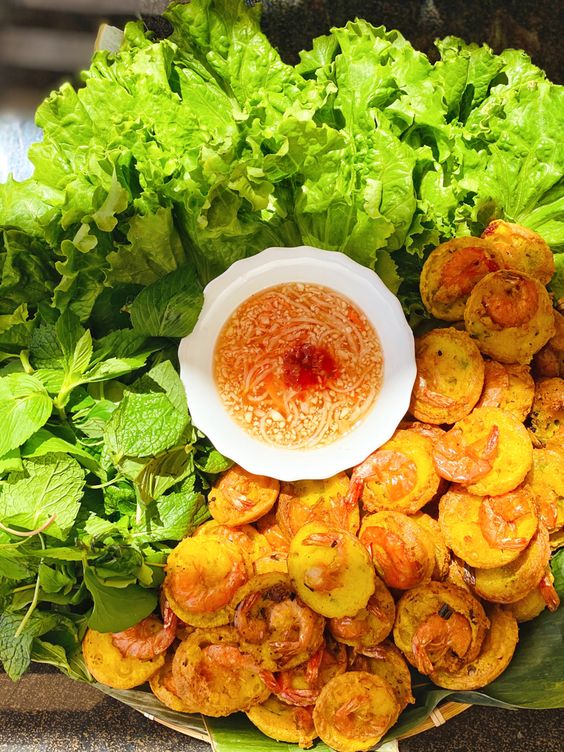Vietnamese street food is known for its variety and bold flavors, from the ever-popular bánh mì to bowls of steaming pho. But there’s one dish that doesn’t always get the spotlight it deserves—bánh khọt.
Hailing from the coastal regions of southern Vietnam, particularly Vũng Tàu, bánh khọt is a crispy, bite-sized wonder that packs a punch of flavor in every bite. It’s not just a snack; it’s a delicious experience that deserves a place in the heart of every street food lover.
To read about the Republic of Vietnam click here.
What Is Bánh Khọt?
If you’ve never heard of bánh khọt, think of it as a smaller, crunchier cousin of the more famous bánh xèo (Vietnamese savory pancakes). While bánh xèo is a larger pancake, often folded and stuffed with shrimp, pork, and bean sprouts, bánh khọt is a smaller, crispy disc, typically topped with shrimp or other seafood. It’s usually made in specialized pans with small, round molds, which give the cakes their signature size and shape.

Photo: Hanna le
The base of bánh khọt is a rice flour batter that’s mixed with coconut milk, giving the cakes a rich, slightly sweet flavor. The batter is poured into the molds and cooked until the bottom turns crispy and golden, while the top remains soft and chewy. The result? A perfect contrast of textures that’s crunchy on the outside and pillowy on the inside.
To read about street food in Hue click here.
The Magic Toppings and Accompaniments
What sets bánh khọt apart from other street food is its toppings and accompaniments. The most common topping is shrimp—often a single piece, shell-on or peeled, depending on where you’re eating—but variations with squid, fish, or even minced pork can also be found. The shrimp is added midway through cooking, allowing it to cook just enough to stay tender while still absorbing the flavors of the pancake.
Bánh khọt is typically served with a plate of fresh herbs—basil, mint, and lettuce—along with slices of cucumber and green mango to add a refreshing crunch. Then there’s the nước chấm, the famous Vietnamese dipping sauce made from fish sauce, lime, sugar, chili, and garlic. This tangy, sweet, and spicy sauce elevates every bite of bánh khọt to new heights. A good dunk in the nước chấm gives the dish that extra kick of flavor, making it impossible to stop at just one.
To read about how to get from Phnom Penh to Saigon click here.
A Hands-On Eating Experience
One of the best things about bánh khọt is that it’s an interactive eating experience. The traditional way to eat it is to wrap each crispy little pancake in a piece of lettuce or a rice paper roll, along with a few herbs and maybe some pickled veggies, before dipping it generously into the nước chấm. It’s a street food dish that’s made to be shared and eaten with your hands, which adds to the fun.
Because the pancakes are bite-sized, it’s easy to eat several in one sitting without even realizing how many you’ve devoured. They’re light, crispy, and the perfect balance of salty, savory, and sweet, with the fresh herbs providing a cooling contrast to the deep-fried goodness of the cakes.
Where to Find Bánh Khọt
While bánh khọt is a street food staple in southern Vietnam, it’s particularly associated with the coastal town of Vũng Tàu, which is said to be the birthplace of this dish. There, you’ll find entire streets dedicated to serving this local delicacy, and many restaurants have perfected the art of making the crispiest, most flavorful versions.
Some of the most popular spots in Vũng Tàu for bánh khọt include Bánh Khọt Gốc Vú Sữa, which has been serving the dish for decades and is often crowded with locals and tourists alike. Another favorite is Bánh Khọt Cô Ba, known for its super-crispy pancakes and generous shrimp toppings.
If you can’t make it to Vũng Tàu, don’t worry—bánh khọt has spread across Vietnam, and you’ll find it in cities like Ho Chi Minh City, where it’s often served in small street-side stalls or humble family-run restaurants. No matter where you try it, you’ll find that bánh khọt is a dish that perfectly captures the essence of Vietnamese street food: simple ingredients, bold flavors, and an emphasis on fresh, locally sourced produce.
To read a guide to Phu Quoc click here.
Bánh Khọt vs. Bánh Xèo: What’s the Difference?
A common question is how bánh khọt differs from bánh xèo, another famous Vietnamese pancake. While they share some similarities—both are made with rice flour and coconut milk—the two dishes are quite different in terms of size, texture, and how they’re eaten.
Bánh xèo is much larger, often the size of a dinner plate, and is folded in half to encase its fillings. It’s also softer, with a slightly chewy texture and a more substantial filling, typically a mix of shrimp, pork, and bean sprouts. Bánh khọt, on the other hand, is much smaller and crispier, with a single piece of shrimp (or other topping) on each pancake. Both are delicious in their own right, but bánh khọt offers a lighter, crunchier option that’s perfect for snacking or sharing.


Photo: Hanna le
Why Bánh Khọt Deserves Your Attention
For anyone exploring the vibrant world of Vietnamese street food, bánh khọt is an absolute must-try. It’s not as famous internationally as pho or bánh mì, but it’s every bit as flavorful and unique. The contrast of textures—crispy, chewy, and fresh—along with the punchy flavors of the shrimp and dipping sauce make it a standout dish that’s unlike anything else you’ll try in Vietnam.
And to make things even better Vietnam officially has the best street food in South-East Asia – says who you say? Says me! So if you’d to give it a try then why not join me on a tour.

